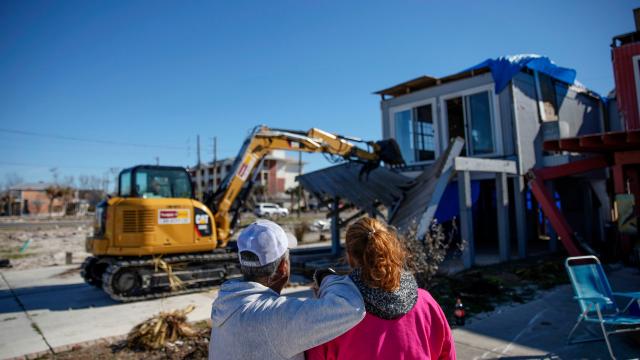The U.S. is slowly being gripped by a barriers won’t be enough to keep floodwaters at bay.
But new research shows a startling finding: Americans are already retreating. More than 40,000 households have been bought out by the federal government over the past three decades. The research published in Science Advances on Wednesday also reveals that there are disparities between which communities opt-in for buyout programs and, even more granularly, which households take the offers and relocate away. The cutting-edge research answers questions that have been out there for a while and raises a whole host of new ones that will only become more pressing in the coming decades as Earth continues to warm.
[referenced url=”https://gizmodo.com.au/2018/02/its-too-late-to-stop-sea-levels-from-rising-so-what-can-we-do/” thumb=”https://gizmodo.com.au/wp-content/uploads/2018/02/ocean-swell-410×231.jpg” title=”It’s Too Late To Stop Sea Levels From Rising, So What Can We Do?” excerpt=”A team of international and Australian researchers say that even if every nation on the planet meets Paris Climate Agreement Targets for emissions, it won’t stop seas levels from rising. By 2300, we’re looking at global rise of 0.7 to 1.2 metres, no matter what. But that doesn’t mean we should scrap the agreement, not at all. Because for every five years we delay meeting the set targets, you can add another 20 centimetres to those levels, according to the study. But what do the experts have to say?”]
“People are using buyouts and doing managed retreat,” AR Siders, a climate governance researcher at Harvard and study author, said during a press call. “No matter how difficult managed retreat sounds, we know that there are a thousand communities in the United States, all over the country, who have made it work. I want to hear their stories, I want to know how they did it.”
The United States’ Federal Emergency Management Agency (FEMA) has been quietly helping Americans move away from coasts and river floodplains since 1989, the researchers found. The program sends federal dollars to state and local governments to help purchase flood-prone homes, often in the wake of disasters. The findings show that there have been more than 43,000 homes bought out since 1989. While that’s a small fraction of the nearly 140 million homes in the U.S., it’s a meaningful sample to tease out some trends.
The researchers conducted a county-by-county analysis of the buyout programs. They found that the number of buyouts has been dropping since the 1990s, a decade that also saw massive river floods roar across the Midwest. The largest number of buyouts, however, is in Harris County, Texas. Fifty-nine projects have taken place there in a county that was whacked by Hurricane Harvey’s record flooding and Tropical Storm Imelda’s heavy rains in just two years.
The findings also zoom in on who exactly is taking the buyouts. The findings show that while wealthier counties tend to offer buyout programs, poorer households are often the ones that participate.
Liz Koslov, a buyout researcher at the University of California, Los Angeles, told Earther there are “several different stories” at play. In some places, notably Oakwood Beach in Staten Island in the wake of Hurricane Sandy, community members have banded together to get a buyout program in place. Koslov said that represents a situation where homeowners have “a level of political power but have [financial] precariousness and need to move.” In other locations, it could be a new form of climate-driven gentrification where, she said, a buyout program could be “used as a tool to remove people who have been serially dispossessed.”
The findings also reveal huge gaps in data about the buyouts, at least as far as FEMA-funded buyouts are concerned. The program is one of the longest-running climate-related buyout programs in the world, yet the new study shows there are large gaps in data collection with more than 50 per cent of the fields FEMA uses to collect data left blank. Even when those fields are all filled in, the picture of the buyouts remains incomplete. More robust data collection could help unravel the mystery of who takes buyouts, why, and where they go.
The latter is particularly important because of concerns that people may leave one dangerous locale for another. Koslov said it would also be pressing to dive even deeper and find out if wealthy buyout takers then move to “higher ground, better inland areas and displacing more people as a gentrifying effect.” Those types of concerns are high on the list of places like Miami’s Little Haiti, which is one of the more elevated parts of the city and has seen a wave of developer interest as the rest of the city gradually gets swallowed by the sea.
Susanne Mosher, a consultant who works on climate adaptation, told Earther in an email that the dip in the number of buyouts also raises a lot of questions. Chief among them are whether it’s being driven by distrust in the government, rising real estate prices that make the programs less able to spread money around, a lack of knowledge about the program, or something else entirely.
Getting these types of gaps filled is vital in a world where trends in sea level rise and heavy precipitation are on the upswing. That will put more places at risk of being inundated with water, and communities will need support to get through it (despite what Andrew Yang may have you believe). Ultimately, that means not just more dollars and federal programs. It means leaders who are clear-eyed about the challenges the 21st century poses.
“None of this will happen without educated and courageous national leadership on climate adaptation in general, and coastal adaptation in particular,” Mosher said.
